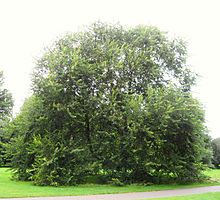- Ulmus villosa
-
Ulmus villosa Ulmus villosa, Kew. Photo: Ronnie Nijboer, Bonte Hoek kwekerijen. Scientific classification Kingdom: Plantae Division: Magnoliophyta Class: Magnoliopsida Order: Rosales Family: Ulmaceae Genus: Ulmus Species: U. villosa Binomial name Ulmus villosa
Brandis ex GambleSynonyms - Marn Elm (Marn = local name in parts of the Kashmir)
- Ulmus laevigata Royle
Ulmus villosa Brandis ex Gamble, the Cherry-bark Elm, is one of the more distinctive Asiatic elms, and a species capable of remarkable longevity. It is endemic to the valleys of the Kashmir at elevations from 1200 m to 2500 m but has become increasingly rare owing to its popularity as cattle fodder, and mature trees are now largely restricted to temples and shrines where they are treated as sacred [1]. Some of these trees are believed to be aged over 800 years [2]
Contents
Description
Growing up to 25 m high, the tree is rather lightly and pendulously branched, the bark smooth with distinctive horizontal bands of lenticels, although it eventually becomes very coarsely furrowed.[3] The oblong-elliptic-acute leaves are < 11 cm long by 5 cm broad. The wind-pollinated apetalous flowers appear in spring, and are particularly densely clustered, the white hairs covering the perianth and ovary contrasting with the purplish anthers. The samarae are elliptic and up to 12 mm long, densely hairy on both sides [4][5].
Pests and diseases
U. villosa has a low susceptibility to Dutch elm disease and the elm leaf beetle Xanthogaleruca luteola [1], but a moderate susceptibility to Elm Yellows [6].
Cultivation
A tree once grown at Kew Gardens, London, attained a height of 25 m and was considered very elegant, although it tended to shed shoots after flowering heavily; it was felled in the 1990s after succumbing to Dutch Elm Disease. Two trees planted as part of the UK Forestry Commission's elm trials at the Westonbirt Arboretum in the 1970s also died, although the cause of death has not been recorded. Plantings elsewhere in Europe are few and far between. Several trees survive in the Gijsbrecht-Amstelpark area of Amsterdam and in the port [2]. Ulmus villosa is not known to be in commerce.
Notable trees
The specimen planted in 1989 at the Sir Harold Hillier Gardens at an exposed location on clay has grown more in width than height to form an amorphous (albeit healthy) mound of vegetation; in 2005 it was 11.6 m high with a trunk 38 cm d.b.h..
Accessions
- North America
- Bartlett Tree Experts [3]. Acc. no. 8384.
- Europe
- Brighton & Hove City Council, UK, NCCPG elm collection [4]. UK champion: Hodshrove Place, 15 m high, 51 cm d.b.h. in 1999 [7]. Tree in Stanmer Park Arboretum, 2008 (Best example in UK).
- Grange Farm Arboretum, Sutton St. James, Spalding, Lincs. UK. Acc. no. 707.
- Royal Botanic Gardens Kew. Acc. no. 1935-69805 (planted 1989).
- Royal Botanic Gardens Wakehurst Place. Acc. nos. 1935-69807, 1935-69809.
- Sir Harold Hillier Gardens. Acc. no. 1989.2869, wild-collected from Sundarnagar Forest, Himachal Pradesh, India.
External Links
References
- ^ Melville, R. & Heybroek, H. M. (1971). The Elms of the Himalaya. Kew Bulletin Vol. 26 (1). Royal Botanic Garden, Kew, London.
- ^ Wadoo, M. S. (2002). Brein - the Trees of Sufis, Saints and Reshies. Kashmir Observer.
- ^ Photograph of bark of mature Ulmus villosa, rogerstreesandshrubs.com villosa
- ^ Bean, W. J. (1981). Trees and shrubs hardy in Great Britain, 7th edition. Murray, London.
- ^ White, J & More, D. (2003). Trees of Britain & Northern Europe. Cassell's, London.
- ^ Mittempergher, L. & Santini, A. (2004). The History of Elm Breeding. Invest. Agrar.: Sist Recur For. 2004 13 (1), 161-177.
- ^ Johnson, Owen (ed.) (2003). Champion Trees of Britain & Ireland. Whittet Press, ISBN 9781873580615
Categories:- Ulmaceae
- Flora of Jammu and Kashmir
- Trees of India
- Flora of Pakistan
- Trees of Asia
- Flora of India
Wikimedia Foundation. 2010.



